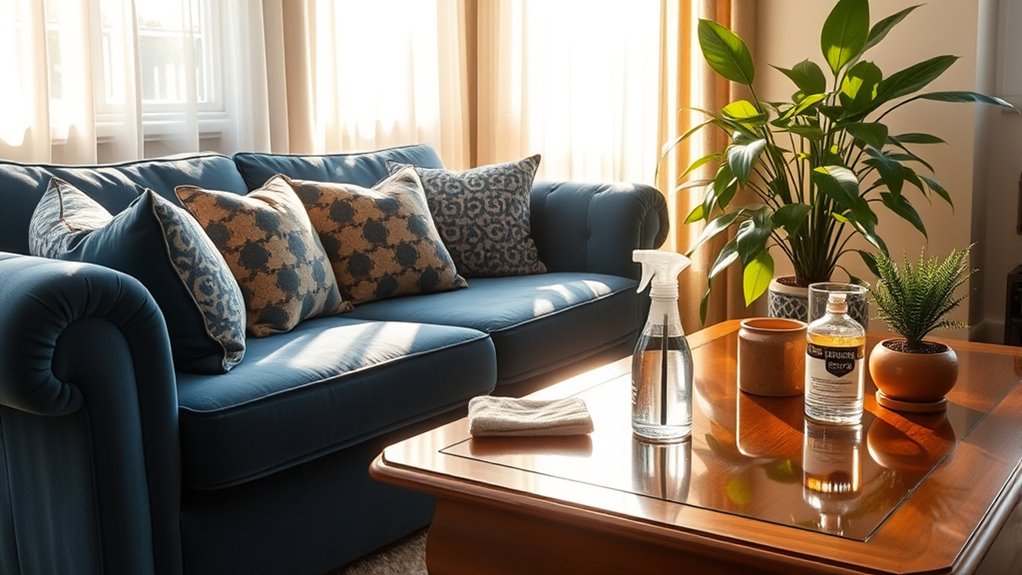Caring for your home furnishings is key to keeping them beautiful and functional. Start with regular cleaning to prevent dust buildup, and address spills immediately to avoid stains. Use the right cleaning methods for different materials, like soft cloths for wood and conditioning for leather. Don’t forget to inspect for wear and repair minor issues before they become major problems. There are plenty of smart strategies to enhance your care routine and maximize the lifespan of your pieces.
Key Takeaways
- Regularly dust and vacuum furniture to prevent dust buildup, which can cause permanent damage to surfaces and upholstery.
- Address spills immediately to avoid stains and damage, using appropriate cleaning methods for each material type.
- Use mild, non-toxic cleaners specifically designed for wood, upholstery, and leather to maintain the integrity of your furnishings.
- Inspect furniture regularly for loose screws, scratches, or wear, and make timely repairs to extend its lifespan.
- Rotate and flip cushions periodically to maintain their shape and prolong the comfort and appearance of upholstered pieces.
Importance of Furniture Maintenance
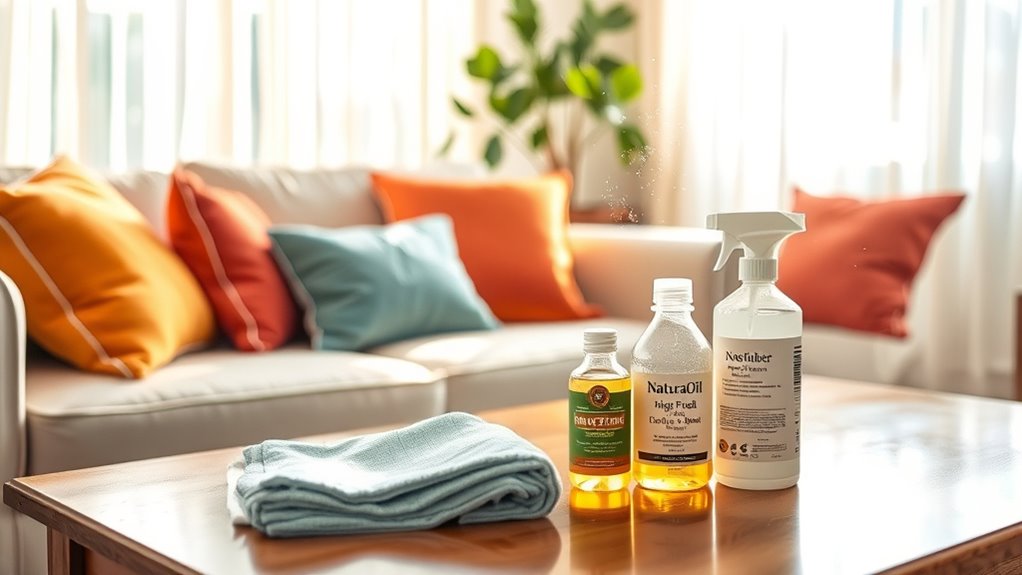
While you mightn’t think about it often, maintaining your furniture is vital for both its longevity and your wallet. Regular furniture maintenance can greatly extend the life of your pieces, potentially saving you thousands in replacement costs. Proactive maintenance, like promptly addressing spills and minor scratches, helps prevent further damage, keeping your furniture in top shape. Consistently removing dust from wooden surfaces is important, as buildup can lead to permanent harm, especially if wood care practices are not followed. Additionally, understanding the importance of energy monitoring features in smart home devices can help you create a more efficient living environment. Incorporating air purifier technology into your home can also improve indoor air quality, further protecting your furnishings from damage caused by pollutants. Understanding the specific care requirements for different materials—like wood, upholstery, or leather—ensures their appearance and longevity. Furthermore, decluttering spaces can enhance the overall appeal of your living area and make it easier to maintain your furniture. By investing time in effective care practices, you not only preserve the integrity of your furnishings but also contribute to reducing the staggering 12.2 million tons of furniture waste generated annually in the U.S. Additionally, incorporating natural materials in your furniture design can enhance visual appeal and promote tranquility in your living space.
General Principles of Furniture Care
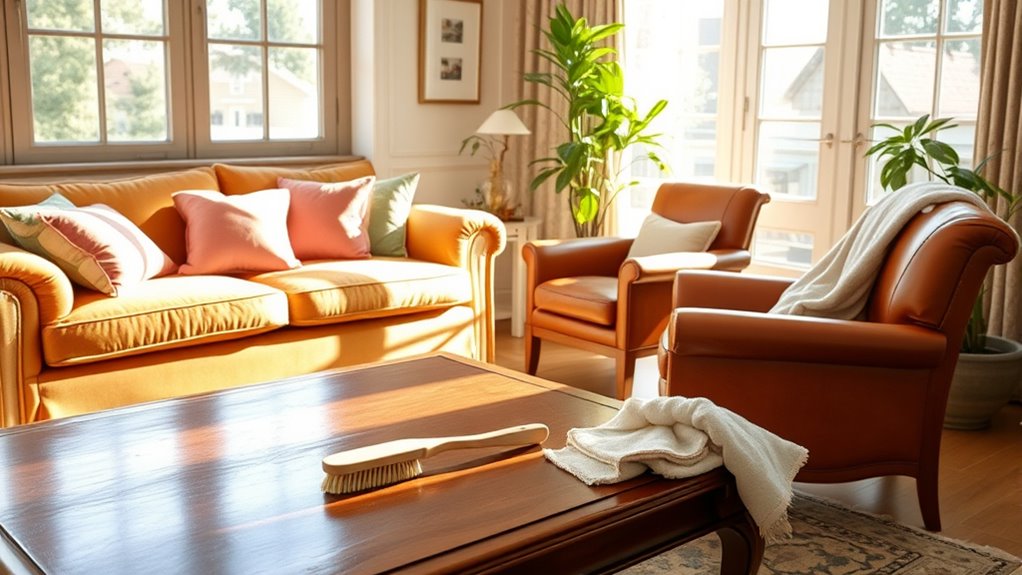
To care for your furniture effectively, you need to understand the specific materials it’s made from, like wood or leather. Regular maintenance, such as top-rated vacuums for cleaning upholstery, plays a key role in keeping your pieces looking great and lasting longer. Additionally, regularly trimming your cat’s nails can help prevent damage to your furniture from scratching. Investing in advanced filtration systems for your vacuum can also help reduce allergens and maintain a healthier home environment. Using a vacuum with suction power appropriate for your upholstery will enhance cleaning efficiency and prolong the life of your furnishings. Furthermore, selecting a vacuum with smart features can greatly improve your cleaning routine and make furniture care more efficient.
Understanding Material Types
Understanding the different material types used in your home furnishings is essential for effective care. Each material—like wood, upholstered furniture, or wicker—has unique maintenance needs. Always check the care label for specific instructions.
For wooden surfaces, routine cleaning and polishing can help maintain their shine, while upholstered furniture benefits from regular vacuuming to remove dust. Don’t forget to use a leather conditioner on leather items to keep them supple.
Quick action on spills or scratches is crucial; addressing these issues promptly prevents permanent damage. Remember, maintenance is key to extending the lifespan of your furniture.
Regular inspections for wear, like loose screws or minor scratches, can help you tackle problems before they escalate.
Consistent Maintenance Importance
Proper care for your home furnishings goes beyond knowing the materials; it’s about establishing a consistent maintenance routine.
Regular maintenance is essential for the longevity of your furniture and helps prevent wear and tear. Quick action on spills can stop minor issues from becoming major problems.
Here are some key practices to keep in mind:
- Remove dust and dirt from surfaces weekly.
- Address spills as soon as they occur.
- Inspect furniture regularly for loose screws or fading finishes.
- Follow manufacturer guidelines for individual care.
- Schedule deep cleanings based on usage.
Cleaning Techniques for Different Furniture Materials
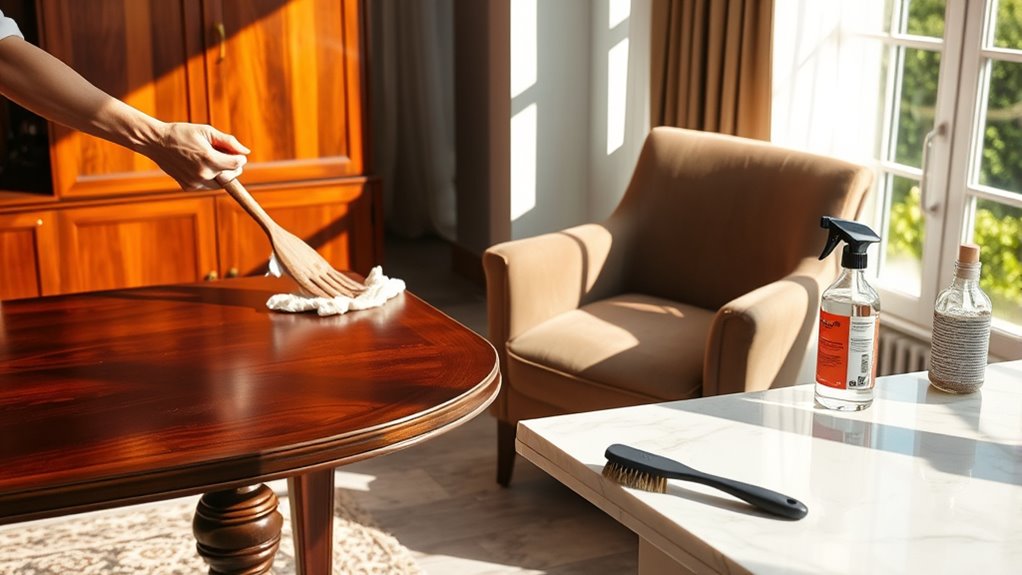
When it comes to cleaning your furniture, different materials need specific care to keep them looking their best.
For wooden pieces, a soft microfiber cloth and a mild cleaner can do wonders, while upholstered furniture requires regular vacuuming and quick spill response.
Leather also needs attention, so remember to wipe it down and condition it periodically to maintain its softness.
Wooden Furniture Care
Caring for wooden furniture requires regular attention to keep it looking its best and to extend its lifespan. Here are some essential Furniture Care Tips:
- Use a soft, damp cloth and mild soap to clean; avoid harsh chemicals.
- Address spills immediately with a clean, absorbent cloth to prevent stains.
- Dust regularly with a microfiber cloth to prevent dirt buildup.
- Polish your furniture every six months to maintain its natural beauty.
- Protect your furniture from direct sunlight and heat sources to avoid fading and warping.
Upholstered Furniture Maintenance
Upholstered furniture can add comfort and style to your home, but it also requires regular maintenance to keep it looking fresh and inviting. Here are some essential maintenance tips:
| Task | Frequency |
|---|---|
| Vacuum to remove dust | Every few weeks |
| Rotate cushions | Every few months |
| Professional cleaning | Every 1-2 years |
Promptly blot spills with a clean, absorbent cloth to prevent stains. For tough marks, try club soda or vinegar. Always follow care labels for removable upholstery and wash them according to instructions. Regularly flipping cushions promotes even wear and helps maintain their shape. For ideal maintenance, invest in professional cleaning for deep cleaning that removes dirt and allergens effectively.
Leather Cleaning Techniques
Although leather furniture is often seen as luxurious, it still requires proper cleaning techniques to maintain its beauty and durability.
Follow these essential tips to care for your leather pieces:
- Dust regularly using a damp soft cloth.
- Vacuum seams to remove dirt and debris.
- For spills, promptly wipe with a clean cloth and use mild saddle soap to remove stains.
- Condition leather every 6 to 12 months with a vinegar-water solution, followed by a leather conditioner.
- Buff out minor scratches using your fingertips or a chamois.
Eco-Friendly Practices
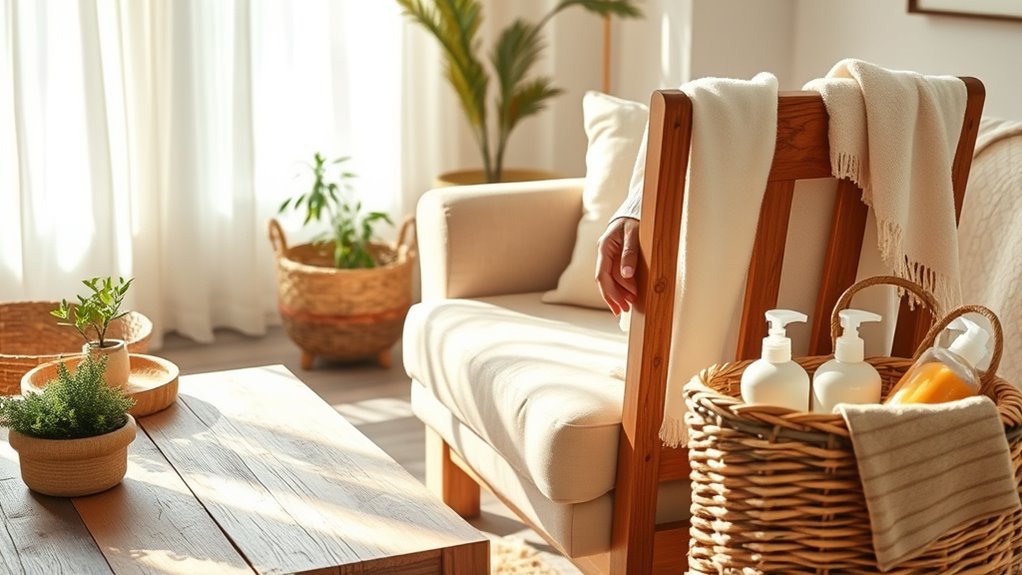
When you consider the impact of your home furnishings on the environment, adopting eco-friendly practices becomes essential.
Start by reupholstering worn fabrics instead of discarding furniture, as this can greatly reduce waste. Refinishing wooden surfaces not only preserves valuable materials but also prevents landfill waste, promoting sustainability. Emphasizing repair over replacement helps minimize your environmental impact.
Utilize protective covers for your furniture to extend its durability, cutting down on the need for frequent replacements. Additionally, choose non-toxic cleaning products for your furniture care routine, ensuring a healthier home environment.
Seasonal Furniture Care
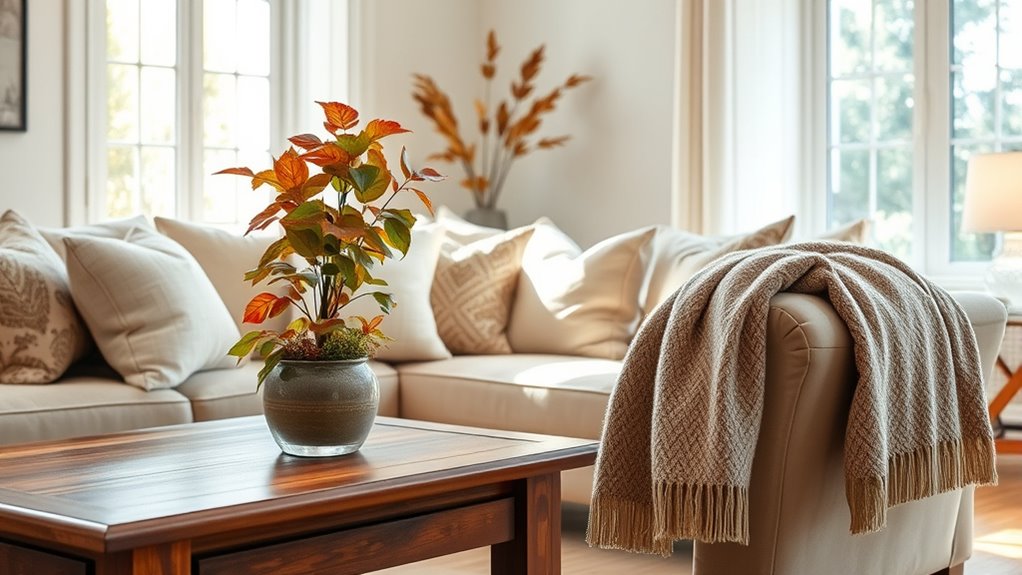
Caring for your furniture throughout the changing seasons is essential for maintaining its beauty and longevity. Here are some tips to help you:
- Use humidifiers in winter to maintain humidity levels between 40-50% and prevent wooden furniture from cracking.
- In summer, utilize dehumidifiers to reduce moisture and prevent mold growth or wood swelling.
- Regularly inspect for seasonal wear, checking upholstery for fading or stress.
- Protect outdoor furniture by storing it indoors during harsh winter conditions or using protective covers.
- Adjust your cleaning routine based on the season, like more frequent dusting in spring due to pollen.
Repair and Restoration Tips
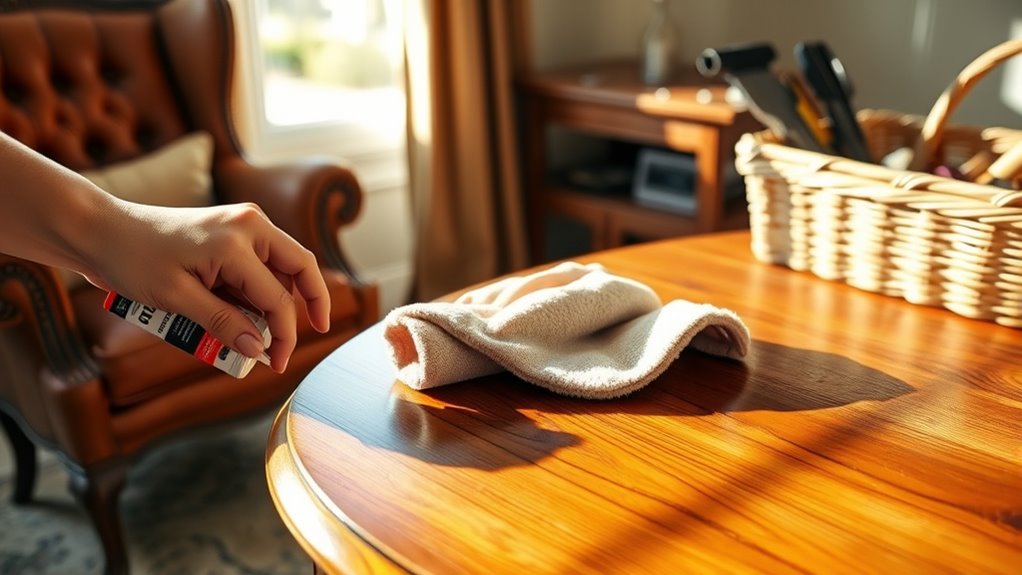
Maintaining your furniture’s beauty through seasonal care is just the beginning; addressing minor repairs can greatly extend its life.
Start by regularly inspecting for issues like loose screws or minor scratches. Use a wood-repair kit to fix minor scratches and blemishes, helping restore the original appearance.
For upholstered furniture, patch tears with fabric glue or sew small rips, and touch up faded areas with fabric dye.
If you have leather pieces, apply a leather conditioner to rejuvenate them and use a color-matching repair kit for deeper scratches.
For wicker furniture, avoid over-wetting and use a soft brush to remove dirt, applying a clear sealant periodically to protect against moisture and UV damage.
Common Mistakes to Avoid
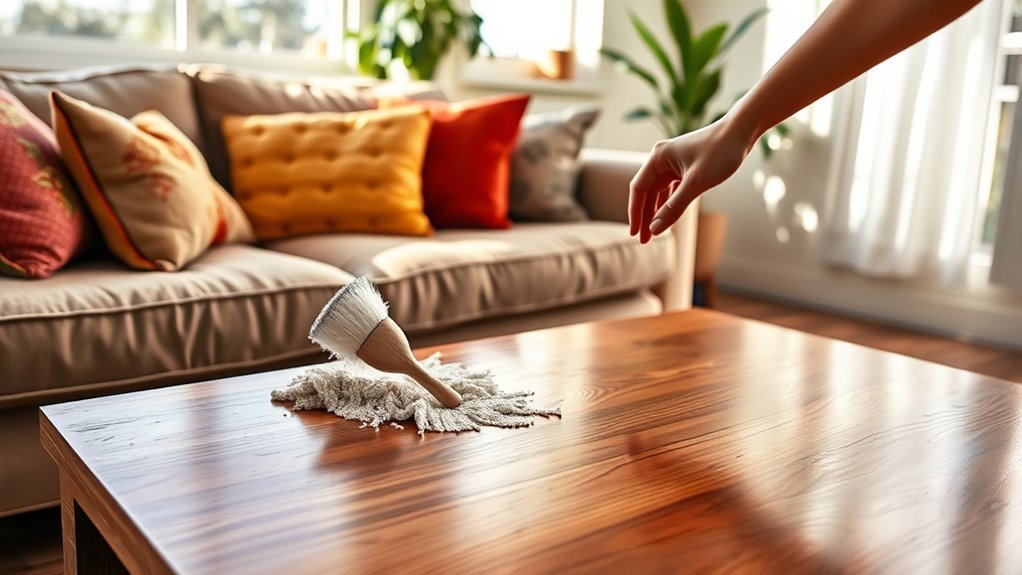
While it’s easy to overlook some aspects of furniture care, avoiding common mistakes can make a significant difference in the longevity and appearance of your home furnishings.
Here are some pitfalls to sidestep:
- Wipe away spills immediately to prevent stains.
- Avoid harsh chemicals on wood; choose wood-specific cleaners instead.
- Rotate and flip cushions regularly to maintain shape.
- Keep leather looking fresh by conditioning it often.
- Use blinds or UV-protective coatings to help prevent fading.
Final Thoughts
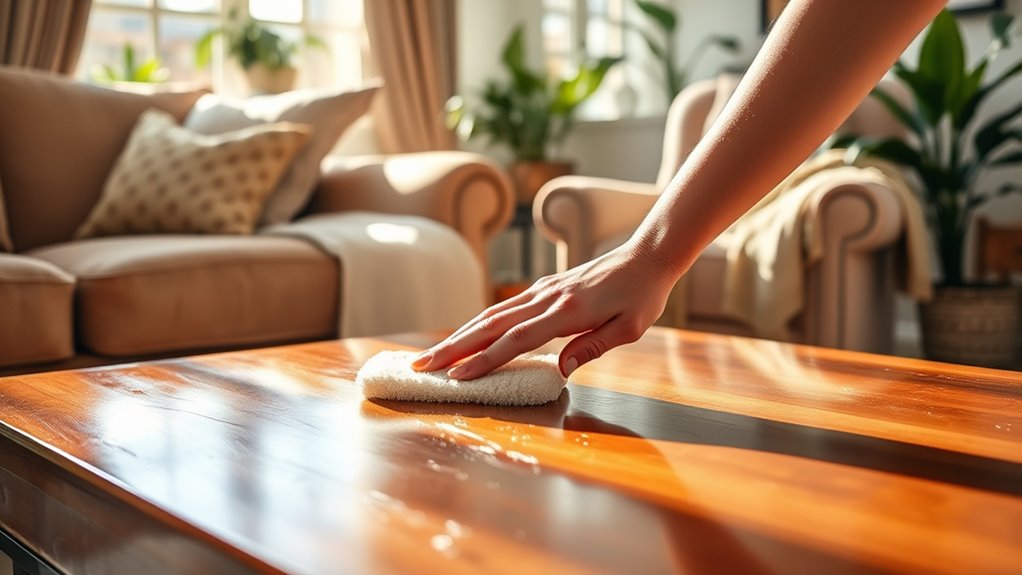
Ultimately, investing time in the care of your home furnishings pays off in the long run. By giving proper care to your furniture pieces, you can keep them looking their best while enhancing their comfort and style.
Regular maintenance, like dusting and addressing spills promptly, is essential to guarantee your furnishings remain functional and beautiful. Don’t forget to adapt your care routine with the seasons, using humidifiers or protective covers as needed.
Quality materials and specific care instructions can greatly extend the lifespan of your items, saving you money on replacements and reducing waste.
With a little effort, you can maintain your home’s aesthetic and protect your investment, ensuring your furnishings stay in top shape for years to come.
Frequently Asked Questions
What Is Proper Care and Maintenance of Furniture?
Proper care and maintenance of furniture is essential for longevity.
You should regularly clean and dust using suitable materials, like soft cloths for wood. Conditioning leather every 6 to 12 months keeps it supple.
Protect wooden pieces from direct sunlight and heat to prevent fading. Address spills immediately with appropriate cleaning methods, and inspect for minor issues, fixing them promptly.
Is Dawn Dish Soap Safe for Wood Furniture?
Yes, Dawn dish soap is safe for wood furniture when used properly.
Just mix a few drops with warm water and apply it with a soft cloth to avoid scratching. Always test the solution on a hidden area first to guarantee it doesn’t discolor the wood.
Avoid using undiluted soap or harsh cleaners, as they can damage the finish.
After cleaning, consider using a wood polish or conditioner to restore the shine.
How to Clean Furniture Every Day?
Imagine your furniture as a canvas, gathering dust like a painter’s palette. To keep it vibrant, you need a daily routine.
Start by dusting surfaces with a soft cloth, then vacuum upholstered pieces, diving beneath cushions like a treasure hunt. Use a damp cloth with wood cleaner for wooden surfaces, wiping away fingerprints.
And if spills occur, blot them immediately to prevent stains. With these quick tasks, your furniture will shine like a masterpiece!
How Often Should You Move Furniture to Clean?
You should move your furniture to clean underneath at least every 3 to 6 months.
If you’ve got high-traffic areas, consider doing it monthly to tackle dust and prevent wear.
During seasonal deep cleaning, shifting larger pieces helps you spot hidden issues like scratches or moisture.
Regularly rotating your furniture not only makes cleaning easier but also extends the lifespan of your upholstery and flooring, keeping your home looking fresh and welcoming.
Conclusion
Taking care of your home furnishings isn’t just about keeping them clean; it’s about nurturing the heart of your home. By following these maintenance tips and tricks, you’re not just preserving your furniture—you’re cherishing the memories and moments they hold. Remember, a little effort goes a long way in ensuring your pieces remain beautiful and functional for years to come. So, give your furnishings the love they deserve, and they’ll continue to bring warmth to your space.
